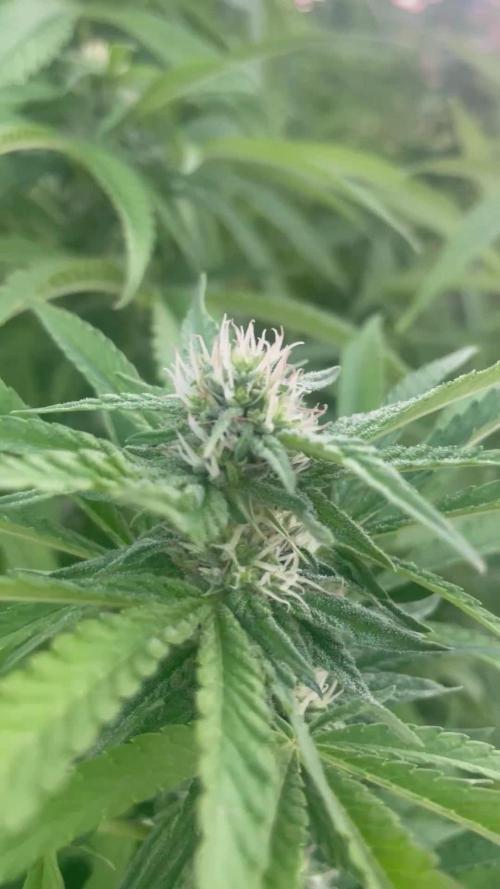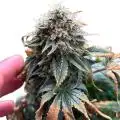The Grow Awards 2026 🏆 































Likes
42
Share


@Ginger_gnome
Follow
Today is official the last day of veg. Turned the light onto 24 hours because I've been running it during the day but now that I've moved it out to my shed that I set up as my new grow space, I want to run it at night when it's colder out.
The plant had a great week of growth as you can tell from the pictures. Plant kicked it into overdrive for its last week and really started to fill up the tent. Unfortunately I didn't think to keep room at the base for watching and now I only have 2 spots I can really water from unless I use a 1/4 cup measuring cup and that'll take forever lol. I'm hoping to have her cropped by Nov.1 to Nov.5 so that I can start using this tent and set up for mother plants. I'll be using a different light then but that's for the next diary.
Well that's all for now so happy growing!!!
Likes
2
Share


@Poohboomin
Follow
Almost ready to start feeding nutrients noticing better results so im guessing they love the new environment.
Likes
33
Share


@GreenAutoConsumo
Follow
Como ya he dicho, siempre ofrece resultados increíbles, la he cultivado tanto en interior como en exterior y siempre sale increíble
Processing
Likes
2
Share


@BigHorn
Follow
After trimming plant from bottom up like a lollipop. Buds have grown bigger, resin is coming in and so are the Crystal's. Plant seems to be loving the Nutrients and conditions. No burn, keeping feeding at 1 liter every other day with 1 teaspoon of Nutrients seems to be doing very well. Got a few more Weeks of budding we will see how it goes.
Likes
4
Share


@I_Identify_As_A_Dan
Follow
Week 7 for 9lb Hammer F2
They have now been getting proper sun light not just shade even though its been quite cloudy the last week with temps dropping a bit at night to 11/12 degrees. Not getting much growth but seem to be drinking more water so hoping the roots are doing some work to push some size by next week. 👊
Likes
8
Share


@Dysons12
Follow
Nutrients completed on majority of the plants some smaller plants will remain being fed until Wednesday before flushing
I rearranged the tents ready for drying purposes with 4 plants that were flushing in the dry room. I came gone to find one had collapsed. This is the heaviest plant (I am interested to see what it yields)
Because it snapped at the stork I hung it up to dry and will be dry Tuesday 29th this week
The rest will be ready after a successful flush.
Earlier in my diary I did a test for which coco was the best. I can assure you that coco eco-thrive produced the tallest and most stacked plants
Plain coco was the next which produced a medium yield plant of medium height.
Last was coco with pebbles. I wanted this to win but believe me it has the worst growth and the least yields for this particular grow.
So I would advise buying the eco thrive coco. It is such a good product if you can get your hands on it.
It’s a very strong smelling this grow please note this when you start. But to be honest value for money I will definately grow this again. (Under $2.00 per seed
This will probably be the last post before the chop.
Stay tuned
05-07-20
30-09-20
Likes
2
Share


@HiddenMessage
Follow
Mid week last week I cut down the inferior PGC. I needed some and it looked done and wasn’t responding to water really. Anyway the buds looked good and get me kinda high. About 1oz smokable buds. This was in 2 gal so not very big. Curing will help. I pressed some into rosin at about day 6 of drying and turned out pretty well. The plant still alive is much better imo and buds should be fire , prob won’t press it
Likes
12
Share


@valiotoro
Follow
Hello everyone week 2 has passed for this LSD-25 auto by Fast Buds 😎
this plant is doing very well growing at fast pace and with a beautiful green colour on the leaves.
Topping & LST for my girl 😎
wish you all happy growing!
Processing
Likes
13
Share


@NOLOGIK
Follow
The plant has the classic structure, low and wide, both have the same characteristics only the vase changes the sample #A and larger, but it seems that this does not bother you at #B! it grows smoothly. I defoliated to allow more air and light ... they are at the beginning of the 5 week and they seem excellent!☺️
Likes
50
Share


@DogDoctorOfficial
Follow
And like a Clock this gir at day 30 or so began flowering, she is a beast , a big beast and a tall one, non so ever she is beautiful and her grown so fur have been nothing but outstanding, very curious to see were these one is going <3 <3 <3
And as the week passes the room starts to get full and in need of some urgent defoliation, and these girl is no exception in there and she is asking for a new air cut
As always thank you all for stoping by and for supporting me on this journey, i am super passion about growing and fell blessed to have you all with me on this new journey <3 <3 <3
Genetics - Fast Buds Tester 2311
Ligth - LUMATEK ZEUS 465 COMPACT PRO
Food - APTUS HOLLAND
#aptus #aptusplanttech #aptusgang #aptusfamily #aptustrueplantscience #inbalancewithnature #trueplantscience #fastbuds #dogdoctorofficial #growerslove
With true love comes happiness <3 <3 <3 Always believe in your self and always do things expecting nothing and with an open heart , be a giver and the universe will give back to you in ways you could not even imagine so <3 <3 <3
All info and full product details can be find in can find @
https://2fast4buds.com/ wen released
https://aptus-holland.com/
https://autopot.co.uk/
https://lumatek-lighting.com/
<3 <3 <3 Growers love to you all <3 <3 <3
Likes
18
Share


@The_Lonely_Farmer
Follow
Tropicana cookies fast flowering just hit the paper towel ✌️ usually within 7 days she'll be popping out the soil 🌱 excited for this one from fastbuds 💚
Likes
39
Share


@SamDo
Follow
Hello,, fin de semaine 6.🤟
Les plantes ont très bien récupérées de leur défoliation de la semaine dernière. Le feuillage est redevenu bien dense.
Je les passe en floraison aujourd’hui. J’ai donc fait une défoliation pour laisser pénétrer un maximum de lumière. En espérant que cela leurs soit profitable. 🤞
Voilà pour cette fin de semaine...
Happy grow...😎
Likes
6
Share


@jaydee702
Follow
This strain is growing fast and flawless so far they are stretching alot more than expected and hope that stops soon running out of room after 4' tall wich is 5' tall from the tent floor was 2' only last week
Likes
8
Share


@legolas40
Follow
The plants are maturing extremly fast, the amber thricomes are apearing so fast and the flushing started to prevent to get much CBN. The BIG DAY is soon!
Likes
55
Share


@Vincent_Van_Grogh
Follow
This is our beagle. She’s 10 yrs old now.
Been with me across three continents.
She likes medicating on trim sometimes.
Starting a journal of her twilight years.
I update my plant diary weekly.
Might as well do one for her too. :)
To healthy dogs and fat buds! 🐶🌱😎
Likes
37
Share


@Pugbutt
Follow
After the move into the larger pots, I noticed the girls starting to lean in, and lift thier leaves. I adjusted the height of the lamp to 23" and thier leaves backed off from over reaching. Thinking of topping this weekend, as the ladies look to have enough nodes now. All in all, things have been going very well.
*** topped 4/5 on sunday
























